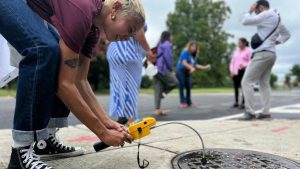
Hologram in Amsterdam Window Seeks Justice for Murdered Sex Worker
A hologram of a young sex worker now appears in Amsterdam’s red light district, haunting visitors with a silent plea for justice. The 3D image, dressed in denim hotpants and a leopard-print bra, represents 19-year-old Bernadette “Betty” Szabo, who was murdered in 2009. As she knocks on the window and breathes “help” onto the glass, this digital presence is part of an innovative campaign by Dutch cold case detectives hoping to solve Szabo’s cold case.
Szabo’s brutal stabbing has remained a mystery for 15 years. Detectives believe the hologram could jog memories and inspire witnesses to come forward with new information. In a district known for its vulnerabilities, Szabo’s hologram serves as a reminder of the dangers sex workers face and the ongoing search for justice.
Unsolved Case: Betty Szabo’s Life and Tragic Death
Betty Szabo moved from Hungary to Amsterdam at 18, where she became pregnant shortly after. Despite the challenges, she worked through her pregnancy and returned to her job soon after giving birth. In the early hours of 19 February 2009, two coworkers found her lifeless body in her brothel room, leading to a murder investigation that has since gone cold.
The investigation into Szabo’s murder initially involved CCTV analysis and witness interviews, but police believe her killer may have been a foreign visitor. With this in mind, they are now urging anyone who visited Amsterdam in 2009 to recall any suspicious behavior. A €30,000 reward is available for information leading to the identification of Szabo’s killer.
External Link: Learn more about the case at BBC
Internal Link: Explore unsolved cases and witness initiatives at Kenkou Land
How Szabo’s Hologram Highlights Risks for Sex Workers
The use of Szabo’s hologram not only aims to solve her murder but also emphasizes the challenges faced by sex workers in Amsterdam. Despite security measures, violence remains a persistent threat, especially as authorities propose relocating Amsterdam’s red-light district to a distant “erotic zone.” Sex workers worry that such a move could further isolate them, increasing risks.
The hologram brings Szabo’s story back to the streets she once walked, serving as a poignant reminder that her killer remains at large. Anne Dreijer-Heemskerk, a detective on the case, commented on Szabo’s resilience and determination, expressing a commitment to finding her killer and achieving justice for her child, who was placed in foster care after her death.
Technology and the Future of Cold Case Investigations
As this cold case investigation in Amsterdam shows, technology like holograms offers new ways to engage the public in unsolved cases. Szabo’s digital presence may compel witnesses who have remained silent to finally come forward. This effort aligns with Amsterdam’s broader concerns over public safety and the visibility of sex workers in areas with a high volume of tourists.
Betty Szabo’s hologram stands as both a call for justice and a symbol of remembrance for those affected by violence in Amsterdam’s red-light district. Authorities and advocates hope that this unique approach can bring closure to a case that has haunted Amsterdam for over a decade.





